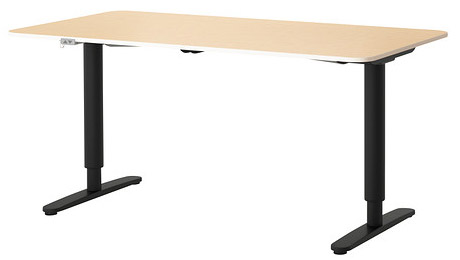IKEA last week introduced a new desk that can be raised and lowered with the push of a button to accommodate both sitting and standing positions.
Part of IKEA’s Bekant line, the desk serves as a hybrid alternative to traditional desks designed purely for sitting or standing, giving users the flexibility to have both options in one.
“This desk promotes a healthy work environment by getting people on their feet,” said Karen Haas, IKEA’s U.S. sales leader for Workspaces. “With the Bekant electric sit/stand underframe, you can adjust the height of your desk with just a touch of a button. This allows you to change your work position as often as you like, keeping your body active.”
Numerous Configurations
The Bekant line offers a variety of tabletop and leg options to create a number of possible combinations and configurations; the items come with a 10-year warranty.
Upgrade possibilities include extra-durable finishes for resisting stains, scratches and scuffs, rounded corners for safety and an updated look, built-in cable management, and attachable or free-standing screens that also can act as notice boards.
Pricing on the new hybrid desk begins at US$489. It’s currently available online, according to IKEA’s website, though company spokesperson Janice Simonsen told TechNewsWorld it soon will be removed while “a labeling issue” is corrected. No word yet on when the desk will arrive in IKEA’s physical stores.
‘Think Small Changes’
“The human body is an adaptable organism that changes in response to environment,” said Cris Dobrosielski, a certified trainer, author, motivational speaker and consultant for theAmerican Council On Exercise.
“Standing desks are good in that they get people off of their butts and onto their feet, loading their bones in their muscles and giving some postural muscles a much needed break,” he told TechNewsWorld.
“However, for every action there are multiple reactions,” Dobrosielski pointed out. “One should not go into a full-time standing position if one has spent the last 10 years sitting at a desk.
“Think small changes, a few minutes a day, over time, leading to the best results,” he suggested. “Some time on a physio-ball is another way to have a positive effect on posture as well.”
Skipping the Overhead
The Bekant hybrid desk’s price is “pretty close to being on target,” said Mike Dunlap, owner and principal of Michael A. Dunlap & Associates.
Making that possible, of course, is the fact that IKEA “doesn’t have the layers and layers of channels and distributors to go through that most contract office furniture manufacturers do,” he told TechNewsWorld. “One of the beauties of IKEA is being able to go directly from manufacturer to customer and skip the additional overhead.”
Though height-adjustable desk chairs have been around for some time, height-adjustable tables “have been slow to come to market,” Dunlap noted. Now, however, acceptance and market penetration are both growing rapidly.
“It seems like everyone is finally getting onto the bandwagon,” he said. “Every company I know that makes the mechanics can’t keep up with the demand.”
Not Necessarily Ergonomic
Adjustable desks have been around “for quite some time, and it has always proven to be a very niche market,” said Jim McGregor, founder and principal analyst with Tirias Research.
“It is nice that you can do it with the push of a button, but it’s a rather plain desk — I guess you would expect that from IKEA,” he told TechNewsWorld.
What’s missing, though, are “all the accessories,” McGregor said. “If you really want to make this ergonomic, then you should have a soft pad for when you are standing, possibly an adjustable chair to convert into one that you can curl your feet under, a rack for a desktop PC and/or workstations, a monitor stand that has adjustable height, an adjustable height keyboard, etc.”
Simply adjusting the height of the desk up and down does not make it an ergonomic solution, in other words — “especially if you are using a laptop PC,” McGregor opined.
That said, “this product might be interesting for retail environments that allow the user to adjust the height and require someone to stand,” he suggested. “Banks, PC and cellphone stores come to mind. I don’t really see this as a fitness solution unless it comes with a treadmill built into it.”






















































